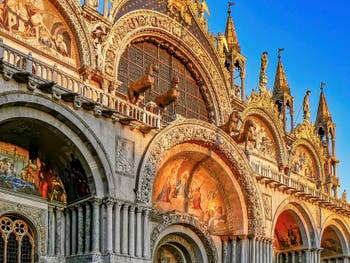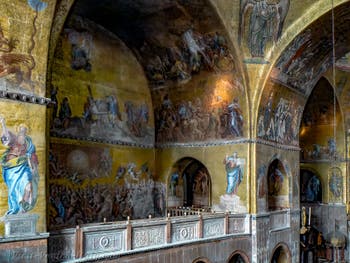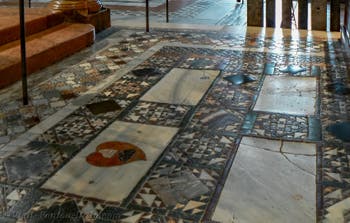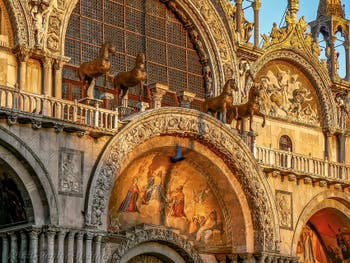Churches Saint-Mark | Miracoli | Stefano | Zaccaria | Murano | Chorus | Mass Hours
Saint-Mark Art Story | Location | Opening Hours Tickets | Authorizations
Art Story Saint Mark's Body | History | Byzantine | Domes and Horses
History of St. Mark's Basilica in Venice Italy
The “Political” location of St. Mark

Saint-Mark Basilica Facade It is significant that the basilica to receive the body of Saint Mark's Evangelist was built right next to the centre of power in Venice, next to the Doge Palace, the residency of the Venetian “ruler”.
True, St. Mark's Church was mainly intended to be the private chapel of the doge.
However, at a time that gave such importance to religious relics, the fact that St. Mark's body was placed in a “private” church and not in a “classical” church clearly shows the importance of the political stakes linked with the arrival of the remains of the Saint in Venice.
This political appropriation of the evangelist's body by Venice is also consistent with the tradition of Hellenistic origin.
The mausoleum of the founding hero of a city should be located next to the residency of the reigning.
Venice does not derogate from this tradition, and this attitude is all the more understandable given the political and strategic importance of Saint Mark's body.
St. Mark Basilica: A mystical and political history of Venice in three phases

Saint-Mark Basilica Apse's Mosaics Otto Demus, a specialist in the subject, distinguishes three fundamental steps:
1. - From the 5th to the beginning of the 9th century:
The Apostolic Foundation and the worship of the Saint are linked to Aquileia and Grado2. - From 828 to the end of the 12th century:
The arrival of Saint Mark's body in Venice gives impetus to this new phase, characterised by the Venetians' interest in the relics themselves.3. - From 1204 to the beginning of the 14th century:
In 1204 it was the capture of Constantinople, a key date in the history of Venice.
Saint-Mark's Floor Marble Mosaics The symbol of Saint Mark is then raised to the same level as the ruling bodies of Venetian political power.
During this period, the emblem and legend will be amplified, and the “celestial revelations” about the myth will grow and multiply.
This phase of the Venetian founding myth will end at the beginning of the 14th century.
The Martyrium of St. Mark Basilica is completed in 883
The early church of St. Mark was completed in 883; it is a central martyrium with a dome.There are, however, many assumptions about the true structure of the first church of St. Mark.

Saint-Mark Basilica's Horses The one that prevails today is that of a “sacellum” in a cross shape.
Indeed, it was customary that the martyriums dedicated to the Apostles had a cross plan.
Moreover, as we have indicated earlier, Giustiniano Partecipazio, the founder father of the basilica of St. Mark, lived in Constantinople when he was elected Doge of Venice, which would further reinforce this hypothesis, which is also in harmony with what was then done in Constantinople in religious and architectural perspective.
It is also thought, as for Zaccaria, built by the same Doge Partecipazio, that the ground of the church was made up of a grid and thus allowed the faithful to see under their feet the relic of the body of Saint Mark.
This hypothesis of a martyrium in “well”, like the central part of that of Saint John of Ephesus at Constantinople, a "sacred well", also as in Zaccaria, with a double staircase to go down, is also very likely.
Art Story Saint Mark's Body | History | Byzantine | Domes and Horses
Saint-Mark Art Story | Location | Opening Hours Tickets | Authorizations
Churches Saint-Mark | Miracoli | Stefano | Zaccaria | Murano | Chorus | Mass Hours
Back to Top of Page

